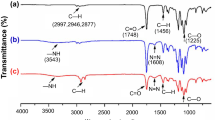Summaries
Amphiphilic networks composed of polydimethylsiloxane (PDMS), poly(2-hydroxyethylacrylate) (PHEA), and poly(acrylic acid) (PAA) have been prepared as thin covalently surface-attached coatings via a protecting group strategy. Atomic force microscopy (AFM) images revealed that both the hydrophobic PDMS phase as well as the hydrophilic PHEA and PAA phase, respectively, are present at the surface and show nanophase separation. The coatings were loaded with Rhodamine B (RB) as a model compound for release experiments. The dye is quickly released from the pure PHEA-I-PDMS coatings of all the compositions. In contrast, the release of RB from the PAA-I-PDMS is greatly delayed over weeks. First experiments with PHEA-I-PDMS coatings loaded with the disinfectant cetyltrimethylammonium chloride showed that the antimicrobial activity against the bacteriumStaphylococcus aureus was retained after washing.
Résumé
Des réseaux amphiphiles et composés de polydiméthylsiloxane (PDMS), de poly(2-hydroxyéthylacrilate) (PHEA), et d’(acide)poly(acrylique) (PAA) ont été traités afin de préparer de minces revêtements qui adhèrent à la surface grâce à un lien covalent par l’intermédiaire d’une stratégie de groupe protecteur. Des images produiles par la microscopie à force atomique (AFM) ont révélé que la phase hydrophobe PDMS aussi bien que la phase hydrophile PHEA et la phase PAA, respectivement, sont présentes à la surface et font preuve d’une séparation nanophasée. Les revêtements étaient chargés de Rhodamine B (RB) en tant que composé modèle pour des expériences de libération. La teinture est vite libérée des revêtements de PHEA-l-PDMS pur dans le cas de toutes les compositions. Par contraste, la libération de RB de la PAA-l-PDMS est retardée pendant des semaines. De premières expériences utilisant des revêtements de PHEA-l-PDMS chargés du désinfectant chlorure de cétyltriméthylammonium ont montré que l’activité antimicrobienne contre la bactérie Staphylococcus aureus était retenue après lavage.
Zusammenfassung
Amphiphile Netzwerke, bestehend aus Polydimethylsiloxan (PDMS) und Poly(2-hydroxyethylacrylat) (PHEA) bzw. Poly(acrylsäure) (PAA) wurden in Form dünner, kovalent oberflächengebundener Beschichtungen über eine Schutzgruppentechnik hergestellt. Rasterkraftmikroskopieuntersuchungen ergaben, dass sowohl die hydrophobe (PDMS) als auch die hydrophile (PHEA bzw. PAA) Phase auf der Oberfläche als Nanophasen zu finden sind. Die Beschichtungen wurden mit dem Modelfarbstoff Rhodamine B (RB) beladen. Der Farbstoff wird schnell aus reinen PHEA-I-PDMS Beschichtungen aller Zusammensetzungen abgegeben. Aus PAA-I-PDMS hingegen, erfolgt die RB-Freisetzung über mehrere Wochen. Erste Experimente mit dem Desinfektionsmittel Cetyltrimethylammoniumchlorid zeigten bereits, dass die antimikrobielle Aktivität beladenener PHEA-I-PDMS Beschichtungen gegen das BakteriumStaphylococcus aureus auch nach ausgedehnter Spülzeit erhalten bleibt.
Similar content being viewed by others
References
Desai N P, S F Hossainy and J A Hubbell, ‘Surface-immobilized polyethylene oxide for bacterial repellence’,Biomaterials,13, 417, 1992
Kurosaka N, T Nihei, H Kumada, T Umemoto, Y Kondo, N Yoshino and T Teranaka, ‘Poly(fluoro)triisocyanatosilane surface modification reduces Streptococcus mutans adherence’,J Dent Res,79, 2569, 2000
Tiller J C, C J Liao, K Lewis and A M Klibanov, ‘Designing surfaces that kill bacteria on contact’, Proceedings from National Academic Sci USA,98, 5981, 2001
Kanazawa A, T Ikeda and T Endo, ‘Polymeric phosphonium salts as a novel class of cationic biocides. III. Immobilization of phosphonium salts by surface photografting and antibacterial activity of the surface-treated polymer films’,J Polym Sci Part A: Polym Chem,31, 1467, 1993
Ohko Y, Y Utsumi, C Niwa, T Tatsuma, K Kobayakawa, Y Satoh, Y Kubota and A Fujishima, ‘Self-sterilizing and self-cleaning of silicone catheters coated with TiO2 photocatalyst thin films: a preclinical work’,J Biomed Mater Res,58, 97, 2000
Blair A, ‘Silver Plating’,Plating Surf Finishes,87, 62, 2000
Dowling D P, Donnelly K, McConnell M L, Eloy R and Arnaud M N, ‘Deposition of anti-bacterial silver coatings on polymeric substrates’,Thin Solid Films,398-9, 602, 2001
Woodyard L, T L Bowersock, J J Turek, G P MyCabe and J DeFord, ‘A comparison of the effects of several silver-treated intravenous catheters on the survival of Staphylococci in suspension and their adhesion to the catheter surface’,J Control Release,40, 23, 1996
Chainer J, ‘Home steel home. AK steel partners with AgION to build world’s first antimicrobial steel house’,AISE Steel Technol,78, 59, 2001
Worley S D, F Li, R Wu, J Kim, C I Wei, J F Williams, J R Owens, J D Wander, A M Bargmeyer and M E Shirtliff, ‘A novel N-halamine monomer for preparing biocidal polyurethane coatings’,Surf Coat International, Part B: Coatings Transactions,86, 273, 2003
Pai M P, S L Pendland and L H Danziger, ‘Antimicrobial-coated/bonded and -impregnated intravascular catheters’,Ann Pharmother,35, 1255, 2001
Lewis K, ‘Programmed death in bacteria’,Microbiol Mol Biol Rev,64, 503, 2000
Sung C, J E Raeder and E W Merrill, ‘Drug partitioning and release characteristics of tricyclic antidepressant drugs using a series of related hydrophilic-hydrophobic copolymers’,J Pharm Sci,79, 829, 1990
Kennedy J P, ‘Amphiphilic networks. XV. Amphiphilic membranes with controlled mesh dimensions for insulin delivery’,Macromol Symp,175, 1022, 2001
DuPrez F E and E J Goethals, ‘Segmented networks by cationic polymerization: design and applications’, NATO Science Series: Applied Sciences,359, 75, 1999
Scherble J, B Ivan and R Mülhaupt, ‘Online monitoring of silicone network formation by means of in-situ mid-infrared spectroscopy’,Macromol Chem Phys,203, 1866, 2002
Tiller J C, S B Lee, K Lewis and A M Klibanov, ‘Polymer surfaces derivatized with poly(vinyl-N-hexylpyridinium) kill airborne and water-borne bacteria’,Biotechnol Bioeng,79, 465, 2002
Author information
Authors and Affiliations
Corresponding author
Rights and permissions
About this article
Cite this article
Tiller, J., Hartmann, L. & Scherble, J. Reloadable antimicrobial coatings based on amphiphilic silicone networks. Surface Coatings International Part B: Coatings Transactions 88, 49–53 (2005). https://doi.org/10.1007/BF02699707
Issue Date:
DOI: https://doi.org/10.1007/BF02699707




